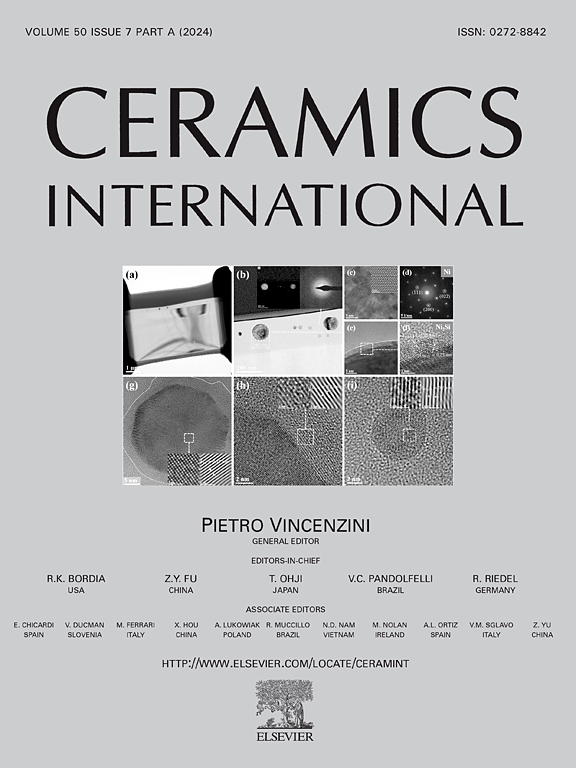Effect of SiO2/B2O3 ratio on high-temperature behavior and crystallization of BaO-CaO-SiO2-Al2O3-B2O3 sealants for SOFCs
IF 5.1
2区 材料科学
Q1 MATERIALS SCIENCE, CERAMICS
引用次数: 0
Abstract
In order to study promising sealant compositions for SOFC systems and explore ways of adjusting their properties, the effect of SiO2 and B2O3 content on key properties of 0.17BaO-0.17CaO-0.05Al2O3-xB2O3-(0.61-x)SiO2 sealants was investigated. It was found that, within the studied concentration range glass-transition temperature, softening point, and other key temperatures monotonously decreased with rising B2O3 content. In particular, softening temperature changed on average by 11 °C per 1 mol% shift in SiO2-B2O3 balance, making the studied compositions suitable for applications in SOFC systems with different sealing and operating temperatures. It was shown that all the studied compositions retained significant amount of amorphous phase after sealing heat treatment, giving them the ability to mitigate thermomechanical stresses. Major phases crystallizing in the studied compositions were Ca2BaSi3O9 and hexacelsian BaAl2Si2O8; these phases are considered desirable for SOFC applications due to their low CTE mismatch. CTEs of all the sealants after thermal treatment were in 10.0–11.0 × 10−6 K−1 range, making them thermomechanically compatible with SOFC materials, both zirconia-based electrolytes and steel interconnects. Long-term stability and thermal cycling tests conducted on a selected sealant composition showed its stability for at least 1000 h in SOFC operating conditions and for 20 thermal cycles from room temperature to 850 °C.

SiO2/B2O3配比对SOFCs密封胶高温性能及结晶的影响
为了研究SOFC体系中有前景的密封胶组合并探索调整其性能的方法,研究了SiO2和B2O3含量对0.17BaO-0.17CaO-0.05Al2O3-xB2O3-(0.61-x)SiO2密封胶关键性能的影响。结果表明:在所研究的浓度范围内,随着B2O3含量的增加,玻璃化转变温度、软化点等关键温度单调降低;特别是,SiO2-B2O3平衡每变化1 mol%,软化温度平均变化11°C,使所研究的组合物适用于不同密封温度和工作温度的SOFC体系。结果表明,在密封热处理后,所研究的所有成分都保留了大量的非晶相,使其具有减轻热机械应力的能力。研究成分中主要结晶相为Ca2BaSi3O9和六相BaAl2Si2O8;由于其低CTE失配,这些相位被认为是SOFC应用的理想选择。所有密封胶热处理后的cte值在10.0 ~ 11.0 × 10−6 K−1范围内,与SOFC材料、氧化锆基电解质和钢互连材料的热机械兼容。对选定的密封胶组合物进行的长期稳定性和热循环测试表明,其在SOFC工作条件下至少稳定1000小时,在室温至850℃的20个热循环中稳定。
本文章由计算机程序翻译,如有差异,请以英文原文为准。
求助全文
约1分钟内获得全文
求助全文
来源期刊

Ceramics International
工程技术-材料科学:硅酸盐
CiteScore
9.40
自引率
15.40%
发文量
4558
审稿时长
25 days
期刊介绍:
Ceramics International covers the science of advanced ceramic materials. The journal encourages contributions that demonstrate how an understanding of the basic chemical and physical phenomena may direct materials design and stimulate ideas for new or improved processing techniques, in order to obtain materials with desired structural features and properties.
Ceramics International covers oxide and non-oxide ceramics, functional glasses, glass ceramics, amorphous inorganic non-metallic materials (and their combinations with metal and organic materials), in the form of particulates, dense or porous bodies, thin/thick films and laminated, graded and composite structures. Process related topics such as ceramic-ceramic joints or joining ceramics with dissimilar materials, as well as surface finishing and conditioning are also covered. Besides traditional processing techniques, manufacturing routes of interest include innovative procedures benefiting from externally applied stresses, electromagnetic fields and energetic beams, as well as top-down and self-assembly nanotechnology approaches. In addition, the journal welcomes submissions on bio-inspired and bio-enabled materials designs, experimentally validated multi scale modelling and simulation for materials design, and the use of the most advanced chemical and physical characterization techniques of structure, properties and behaviour.
Technologically relevant low-dimensional systems are a particular focus of Ceramics International. These include 0, 1 and 2-D nanomaterials (also covering CNTs, graphene and related materials, and diamond-like carbons), their nanocomposites, as well as nano-hybrids and hierarchical multifunctional nanostructures that might integrate molecular, biological and electronic components.
 求助内容:
求助内容: 应助结果提醒方式:
应助结果提醒方式:


